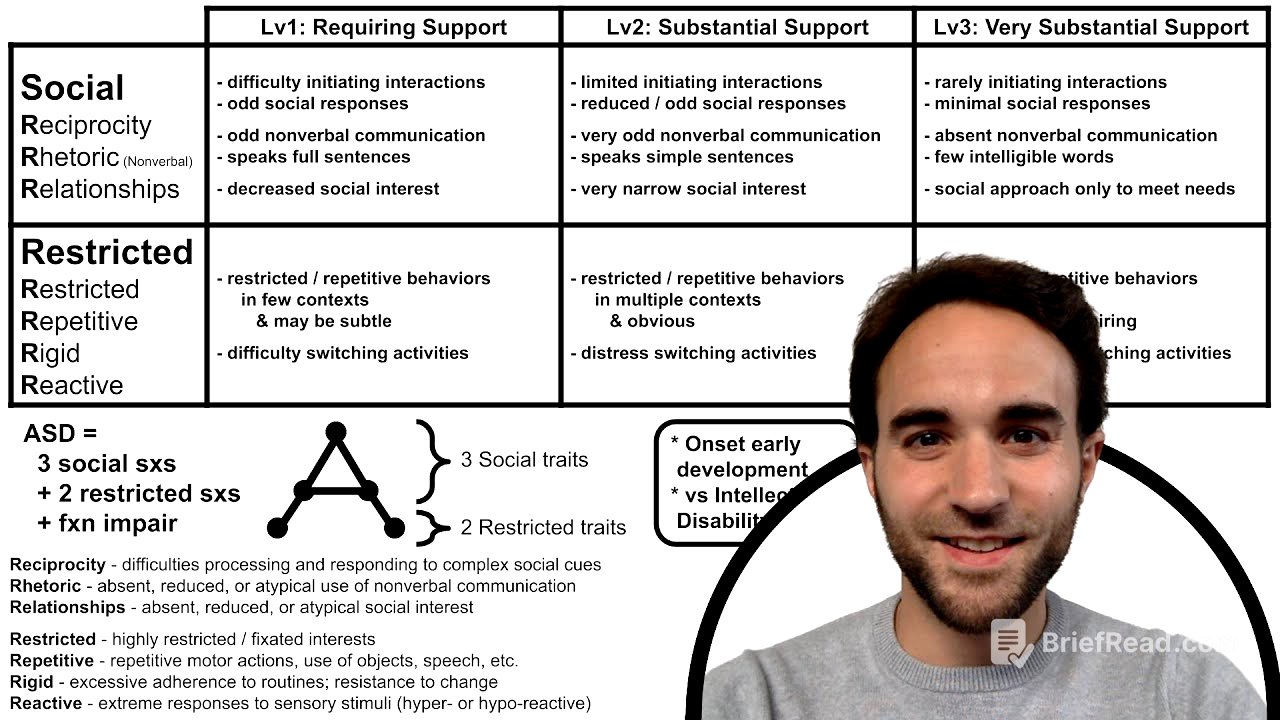TLDR;
This video provides an overview of the diagnostic criteria for Autism Spectrum Disorder (ASD) as outlined in the DSM-5. It explains the two major symptom clusters: social impairment and restricted behaviors, detailing the specific symptoms within each category. The video also discusses the levels of severity in ASD based on the amount of support a patient requires, illustrating the differences in social and behavioral symptoms across these levels.
- Diagnostic criteria for ASD according to DSM-5
- Two major symptom clusters: social impairment and restricted behavior
- Three severity levels based on required support
Introduction to ASD Diagnosis [0:00]
The video introduces the topic of Autism Spectrum Disorder (ASD) diagnosis, explaining that it will cover the diagnostic criteria as defined in the DSM-5. The presentation will use pneumonics and visuals to aid in understanding the two primary symptom clusters associated with ASD: social impairment and restricted behaviors.
Social Impairment Symptoms [0:14]
The video describes the three symptoms related to social impairment in ASD: reciprocity, rhetoric, and relationships. Reciprocity involves difficulties in understanding and responding to social cues, such as knowing how to join a conversation. Rhetoric refers to atypical use of non-verbal communication like eye contact and gestures. Relationships involve reduced social interest, such as difficulty in making friends or being overly passive when interacting with others.
Restricted Behavior Symptoms [1:02]
The video outlines the four restricted behavior symptoms: restricted interests, repetitive behaviors, rigid adherence to routines, and reactive responses to sensory stimuli. Restricted interests involve intense preoccupation with specific topics. Repetitive behaviors include motor actions or speech patterns, often referred to as stemming. Rigid behaviors involve distress when routines are disrupted. Reactive responses include extreme reactions to sensory input, such as sounds or textures. The acronym "RRRR" is used to help remember these symptoms.
Diagnostic Criteria and Key Considerations [2:22]
To meet the diagnostic criteria for ASD, a patient must exhibit all three social impairment symptoms and at least two of the restricted behavior symptoms, leading to functional impairment. Symptom onset must occur during early development. It's important to differentiate ASD from intellectual disability, as their symptoms can be similar depending on the severity of the intellectual disability.
Severity Levels of ASD [3:08]
The video discusses the three severity levels of ASD, which are based on the level of external support the patient requires. In the lowest severity level, individuals may have difficulty initiating social interactions and exhibit subtle restricted behaviors. In the substantial support level, social interactions are limited, non-verbal communication is odd, and repetitive behaviors are obvious. In the very substantial support level, individuals rarely initiate interactions, have minimal communication, and exhibit severely impairing repetitive behaviors in all contexts.
